List of Entolomataceae genera
The mushroom genera in the family Entolomataceae collectively contain over 1500 species, the large majority of which are in Entoloma.[1][2] There have been many different classifications of this group, and so the table below includes not only genera which are supposedly current, but also other proposed genera whose names have been important. For instance several taxa such as Leptonia and Nolanea were defined as independent genera, and are still sometimes used as such, but in recent classifications they have been demoted to being subgenera of Entoloma.
Previously there was a view that Entolomataceae with angular (polyhedral) spores should be classified in genus Entoloma, those with bumpy spores should be in Rhodocybe, and those with longitudinally ridged spores should be put in Clitopilus. However DNA studies in 2009 and 2017 have changed this situation for the Rhodocybe/Clitopilus group. Firstly Clitopilus was found to be a clade embedded within Rhodocybe meaning that to avoid polyphyly these genera have to be merged, and although Clitopilus is much smaller, its name takes precedence and should be used for the combined taxon.[2] Secondly on further analysis taking account of morphological characteristics, the older genera Clitopilopsis and Rhodophana have been resurrected [3] and a new genus Clitocella has been created. Also in 2011 the genus Entocybe was defined and accepted.[4] These changes are now incorporated in Species Fungorum and so they should be regarded as accepted.[5]
In spite of these changes Entoloma is an enormous genus, and it is not surprising that attempts have been made to split it up.[2][6]
The photos sometimes show the type species of the group in question, or otherwise another typical species. Hold the cursor over a photo for more information.
| Genus, author & date | Current status | Further details | Image |
|---|---|---|---|
| Alboleptonia Largent & R.G. Benedict (1970)[5] | Transferred to Entoloma[7] | Sometimes regarded as a subgenus of Entoloma.[8] Contains about 6 species, including E. sericellum. | 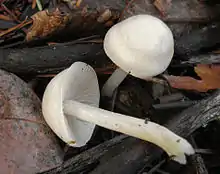 |
| Claudopus Gillet (1876)[5] | Transferred to Entoloma[7] | This old genus contained about 9 species which are now classified in the Entolomataceae (all Entoloma). Sometimes regarded as a subgenus of Entoloma.[8] | 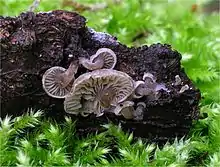 |
|
Clitocella Kluting, T.J. Baroni & Bergemann (2014)[5] |
Currently valid[7][3] | This new genus of 3 former Rhodocybe species, was defined based on distinctive spore wall characteristics.[3] | |
| Clitopilopsis Maire (1937)[5] | Currently valid[7][3] | After having invented genus Rhodocybe, Maire made a new genus for these 5 species which was not accepted for many years, the species being classified in Clitopilus or Rhodocybe. Now after DNA analysis the genus has been resurrected.[3] | |
| Clitopilus (Fr. ex Rabenh.) P. Kumm. (1871) | Currently valid [7] | Should contain all species with longitudinally ridged spores and also recently most former Rhodocybe species have been moved into this genus.[2][3] The best-known member is probably Clitopilus prunulus (the Miller). | 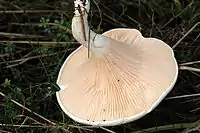 |
| Eccilia (Fr.) P. Kumm. (1871)[5] | Transferred to Entoloma (except E. haeusleriana)[7] | May be considered a subgenus of Entoloma. These mushrooms have decurrent gills and have an omphalinoid or pleurotoid form. Contains almost the same species as Claudopus.[9][10] |  |
| Entocybe T.J. Baroni, V. Hofst. & Largent (2011) | Currently valid[5][7] | Recently defined based on the spore shape and DNA analysis.[4] | 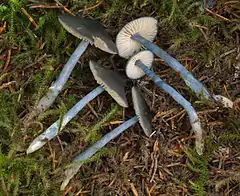 |
| Entoloma (Fr.) P. Kumm. (1871) | Currently valid[7] | According to current definition, contains all species with angular spores. | 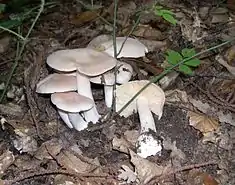 |
| Inocephalus (Noordel.) P.D. Orton (1991)[5] | Transferred to Entoloma[7] | 2 species [8] | |
| Leptonia (Fr.) P. Kumm. (1871) | Transferred to Entoloma[7] | May be considered a subgenus of Entoloma. These mushrooms are collybioid and often have a navel-like depression in the centre of the cap.[9] |  |
| Nolanea (Fr.) P. Kumm. (1871) | Transferred to Entoloma[7] | May be considered a subgenus of Entoloma. Thin-fleshed species, often conical or campanulate, with gills often almost free from the stem.[9] |  |
| Paraeccilia Largent (1994) | Part of Entoloma[7] | This genus proposed in 1994 contained 3 species. | |
| Pouzarella Mazzer (1976) | Part of Entoloma[7] | May be considered a subgenus of Entoloma, with about 10 species. These fungi have campanulate caps and dark gills, and have a fibrous stipe with coarse hairs at the base.[8][11] | |
| Pouzaromyces Pilát (1953) | Part of Entoloma[7] | May be considered a subgenus of Entoloma, with about 9 species. There is overlap between this subgenus and Pouzarella (e.g. E. versatile). It is similar to Nolanea, but the cap is woolly/fibrous.[9] | |
| Rhodocybe Maire (1925) | Obsolete[7][5] | Recently merged mostly into Clitopilus, the name of which takes historical priority, but some species moved to Clitocella, Clitopilopsis & Rhodophana.[2][3] | 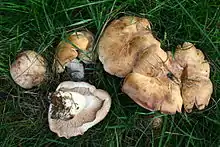 |
| Rhodocybella T.J. Baroni & R.H. Petersen (1987) | Currently valid[7] | Contains just one cyphelloid species, R. rhododendri.[12][13] Not to be confused with Rhodocyphella, which belongs to the Tricholomataceae. | |
| Rhodogaster E. Horak (1964) | Currently valid[7] | Contains 2 gasteroid species. It is proposed that these species should be integrated into Entoloma.[2] | |
| Rhodophana Kühner (1971) | Currently valid[7] | Considered part of Rhodocybe but resurrected in 2014, based on clamp connections and structure of cap skin.[3] | 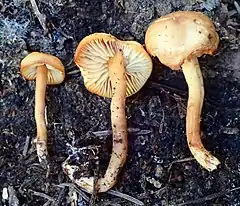 |
| Rhodophyllus Quél. (1886) | Obsolete synonym of Entoloma[7] | This name was used by the influential French mycologists Kühner and Romagnesi.[14] | |
| Richoniella Costantin & L.M. Dufour (1916) | Currently valid[7] | Contains 5 gasteroid species. In spite of not having an agaric body plan, it is proposed that this genus should be integrated into Entoloma.[2] |
References
- Kirk PM, Cannon PF, Minter DW, Stalpers JA (2008). Dictionary of the Fungi (10th ed.). Wallingford: CABI. p. 237. ISBN 978-0-85199-826-8.
- Co-David, D; Langeveld, D; Noordeloos, ME (Nov 2009). "Molecular phylogeny and spore evolution of Entolomataceae" (PDF). Persoonia. 23 (2): 147–176. doi:10.3767/003158509x480944. PMC 2802732. PMID 20198166. Archived from the original (PDF) on 2011-07-27.. See also this web page by M. Noordeloos Archived 2011-07-24 at the Wayback Machine which summarizes the information from the paper.
- K.L. Kluting; T.J. Baroni; S.E. Bergemann (2017). "Toward a stable classification of genera within the Entolomataceae: a phylogenetic re-evaluation of the Rhodocybe-Clitopilus clade". Mycologia. 106 (6): 1127–1142. doi:10.3852/13-270. PMID 24987124.
- Baroni TJ, Hofstetter V, Largent DL, Vilgalys R (2011). "Entocybe is proposed as a new genus in the Entolomataceae (Agaricomycetes, Basidiomycota) based on morphological and molecular evidence" (PDF). North American Fungi. 6 (12): 1–19. doi:10.2509/naf2011.006.012.
- To see the Index Fungorum entry for any of these (possibly obsolete) genera, go to the search page, select the "Genus" level, type the name of the genus, and click "Search". Clicking in the left column gives a page with the Type species ("Typification Details"). To see if this is a current genus, click on the type species and then on "Species Fungorum synonymy"; this is a current genus only if the current name of the type species uses this genus. Species Fungorum can have species marked as current but with an obsolete genus name (but that is not possible for the type species). These orphaned species have not had the new combination defined for them, usually because they are very old names of which the meaning is unclear.
- For a list of Entolomataceae genera, see New Zealand Fungi page.
- To see the list of species of the given (possibly obsolete) genus in Species Fungorum, use a URL like http://www.speciesfungorum.org/Names/Names.asp?strGenus=Clitopilopsis, but substitute the appropriate genus name.
- See relevant entry in Courtecuisse, Régis; Duhem, B. (1994). Guide des champignons de France et d'Europe. Delachaux et Niestlé. ISBN 978-2-603-00953-6. also available in English.
- See definitions of the various subgenera in Bon, Marcel (1987). The Mushrooms and Toadstools of Britain and North-Western Europe. Hodder & Stoughton. ISBN 978-0-340-39935-4..
- It is difficult to find information about the New Zealand fungus Eccilia haeusleriana. See .
- See Machiel Noordeloos's Entoloma site Archived 2011-07-24 at the Wayback Machine.
- Timothy J. Baroni & Ronald H. Petersen (1987). "Rhodocybella: A new genus in the Entolomataceae". Mycologia. 79 (3): 358–361. doi:10.2307/3807456. JSTOR 3807456.
- Philomena Bodensteiner; Manfred Binder; Jean-Marc Moncalvo; Reinhard Agerer; David S. Hibbett (2004). "Phylogenetic relationships of cyphelloid homobasidiomycetes" (PDF). Molecular Phylogenetics and Evolution. 33 (2): 501–515. doi:10.1016/j.ympev.2004.06.007. PMID 15336682. Archived from the original (PDF) on 2011-07-19.
- Robert Kühner & Henri Romagnesi (1974). Flore analytique des champignons supérieurs (agarics, bolets, chanterelles). Paris: Masson. p. 176. ISBN 978-2-225-53713-4.